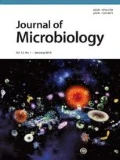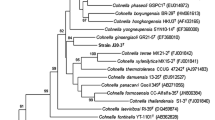Abstract
Strain L15T, a Gram-negative, motile, orange colored bacterium was isolated from pond soil in the surrounding area of a hexachlorocyclohexane (HCH) dump site at Ummari village in Lucknow, India. Phylogenetic analysis based on 16S rRNA gene sequence showed that strain L15T belongs to the family Hyphomicrobiaceae in the order Rhizobiales. Strain L15T showed highest 16S rRNA gene sequence similarity to Devosia chinhatensis IPL18T (98.0%). Chemotaxonomic data revealed that the major fatty acids were summed feature 8 (C18:1 ω7c and/or C18:1 ω6c), C18:1 ω7c 11-methyl, C16:0 and C18:0. The major polar lipids of strain L15T were diphosphatidylglycerol and phosphatidylglycerol. The genomic DNA G+C content of strain L15T was 59.8%. Polyamine profile showed the presence of sym-homospermidine with traces of putrescine. Ubiquinone Q-10 was the major respiratory quinone present. Based on these data, strain L15T (=CCM 7977T =DSM 25398T) was classified as a type strain of a novel species, for which the name Devosia lucknowensis sp. nov. is proposed.
Similar content being viewed by others
References
Arden-Jones, M.P., McCarthy, A.J., and Cross, T. 1979. Taxonomic and serological studies on Micropolyspora faeni and Micropolyspora strains from soil bearing the specific epithet rectivirgula. J. Gen. Microbiol.115, 343–354.
Bautista, V.V., Monsalud, R.G., and Yokota, A. 2010. Devosia yakushimensis sp. nov., isolated from root nodules of Pueraria lobata (Willd.) Ohwi. Int. J. Syst. Evol. Microbiol.60, 627–632.
Bligh, E.G. and Dyer, W.J. 1959. A rapid method of total lipid extraction and purification. Can. J. Biochem. Physiol.37, 911–917.
Busse, J. and Auling, G. 1988. Polyamine patterns as a chemotaxonomic marker within the Proteobacteria. Syst. Appl. Microbiol.11, 1–8.
Christensen, W.B. 1946. Urea decomposition as a means of differentiating Proteus and para-colon cultures from each other and from Salmonella and Shigella types. J. Bacteriol.52, 461–466.
Collins, M.D. and Jones, D. 1980. Lipids in the classification and identification of coryneform bacteria containing peptidoglycan based on 2,4-diamino butyric acid (DAB). J. Appl. Bacteriol.48, 459–470.
Cowan, S.T. and Steel, K.J. 1965. Manual for the Identification of Medical Bacteria. Cambridge University Press, London, UK.
Dadhwal, M., Singh, A., Prakash, O., Gupta, S.K., Kumari, K., Sharma, P., Jit, S., Verma, M., Holliger, C., and Lal, R. 2009. Proposal of biostimulation for hexachlorocyclohexane (HCH) decontamination and characterization of culturable bacterial community from high dose point HCH contaminated sites. J. Appl. Microbiol.106, 381–392.
Felsenstein, J. 1981. Evolutionary trees from DNA sequences: a maximum likelihood approach. J. Mol. Evol.17, 368–376.
Garg, N., Bala, K., and Lal, R. 2011. Sphingobium lucknowense sp. nov., a hexachlorocyclohexane (HCH) degrading bacterium isolated from HCH contaminated soil. Int. J. Syst. Evol. Microbiol.62, 618–623.
Gonzalez, J.M. and Saiz-Jimenez, C. 2002. A fluorimetric method for the estimation of G+C mol% content in microorganism by thermal denaturation temperture. Environ. Microbiol.4, 770–773.
Hamana, K., Sakamoto, A., Tachiyanagi, S., Terauchi, E., and Takeuchi, M. 2003. Polyamine profiles of some members of the Alpha subclass of the class Proteobacteria: Polyamine analysis of twenty recently described genera. Microbiol. Cult. Coll.19, 13–21.
Jindal, S., Dua, A., and Lal, R. 2012. Sphingopyxis indica sp. nov., isolated from a high dose point hexachlorocyclohexane (HCH) contaminated dumpsite. Int. J. Syst. Evol. Microbiol. doi:10.1099/ijs.0.040840-0.
Jukes, T.H. and Cantor, C.R. 1969. Evolution of protein molecules. In Munro, H.N. (ed.) Mammalian protein metabolism, vol. III, pp. 21–132. Academic Press, New York, USA.
Kim, O.S., Cho, Y.J., Lee, K., Yoon, S.H., Kim, M., Na, H., Park, S.C., Jeon, Y.S., Lee, J.H., Yi, H., andet al. 2012. Introducing EzTaxon-e: a prokaryotic 16S rRNA gene sequence database with phylotypes that represent uncultured species. Int. J. Syst. Evol. Microbiol.62, 716–721.
Kumar, M., Verma, M., and Lal, R. 2008. Devosia chinhatensis sp. nov., isolated from Hexachlorocyclohexane (HCH) dump site in India. Int. J. Syst. Evol. Microbiol.58, 861–865.
Kuykendall, L.D., Roy, M.A., Neill, J.J., and Devine, T.E. 1988. Fatty acids, antibiotic resistance and deoxyribonucleic acid homology groups of Bradorhizobium japonicum. Int. J. Syst. Evol. Bacteriol.38, 358–361.
Lee, S.D. 2007. Devosia subaequoris sp. nov., isolated from beach sediment. Int. J. Syst. Evol. Microbiol.57, 2212–2215.
McCarthy, A.J. and Cross, T. 1984. A taxonomic study of Thermomonospora and other monosporic actinomycetes. J. Gen. Microbiol.130, 5–25.
Miller, L.T. 1982. Single derivatization method for the routine analysis of whole-cell fatty acid methyl esters, including hydroxyl acids. J. Clin. Microbiol.16, 584–586.
Nakagawa, Y., Sakane, T., and Yokota, A. 1996. Transfer of “Pseudomonas riboflavina” (Foster 1944), a gram-negative, motile rod with long-chain 3-hydroxy fatty acids, to Devosia riboflavina gen. nov., sp. nov., nom. rev. Int. J. Syst. Bacteriol.46, 16–22.
Rivas, R., Willems, A., Subba-Rao, N.S., Mateos, P.F., Dazzo, F.B., Kroppenstedt, R.M., Martínez-Molina, E., Gillis, M., and Velázquez, E. 2003. Description of Devosia neptuniae sp. nov. that nodulates and fixes nitrogen in symbiosis with Neptunia natans, an aquatic legume from India. Syst. Appl. Microbiol.26, 47–53.
Ryu, S.H., Chung, B.S., Le, N.T., Jang, H.H., Yun, P.Y., Park, W., and Jeon, C.O. 2008. Devosia geojensis sp. nov., isolated from diesel-contaminated soil in Korea. Int. J. Syst. Evol. Microbiol.58, 633–636.
Saxena, A., Anand, S., Dua, A., Sangwan, N., Khan, F., and Lal, R. 2012. Novosphingobium lindaniclasticum sp. nov., a hexachlorocyclohexane (HCH)-degrading bacterium isolated from HCH Dumpsite. Int. J. Syst. Evol. Microbiol. doi:10.1099/ijs.0.045443-0.
Smibert, R.M. and Krieg, N.R. 1994. Phenotypic characterization, Methods for General and Molecular Bacteriology, pp. 607–654. In Gerhardt, P., Murray, R.G.E., Wood, W.A., and Krieg, N.R. (eds.). American Society for Microbiology, Washington, D.C., USA.
Thompson, J.D., Gibson, T.J., Plewniak, F., Jeanmougin, F., and Higgins, D.G. 1997. The CLUSTAL-X windows interface: Flexible strategies for multiple sequence alignment aided by quality analysis tools. Nucleic Acids Res.25, 4876–4882.
Tourova, T.P. and Antonov, A.S. 1987. Identification of microorganisms by rapid DNA-DNA hybridization. Meth. Microbiol.19, 333–355.
Van de Peer, Y. and De Wachter, Y. 1994. TREECON for Windows: A software package for the construction and drawing of evolutionary trees for the Microsoft Windows environment. Comput. Appl. Biosci.10, 569–570.
Vanbroekhoven, K., Ryngaert, A., Bastiaens, L., Wattiau, P., Vancanneyt, M., Swings, J., Mot, R.D., and Springael, D. 2004. Streptomycin as a selective agent to facilitate recovery and isolation of introduced and indigenous Sphingomonads from environmental samples. Environ. Microbiol.6, 1123–1136.
Vanparys, B., Heylen, K., Lebbe, L., and De Vos, P. 2005. Devosia limi sp. nov., isolated from a nitrifying inoculum. Int. J. Syst. Evol. Microbiol.55, 1997–2000.
Verma, M., Kumar, M., Dadhwal, M., Kaur, J., and Lal, R. 2009. Devosia albogilva sp. nov. and Devosia crocina sp. nov., isolated from a hexachlorocyclohexane dump site. Int. J. Syst. Evol. Microbiol.59, 795–799.
Wayne, L.G., Brenner, D.J., Colwell, R.R., Grimont, P.A.D., Kandler, O., Krichevsky, L.H., Moore, L.H., Moore, W.E.C., Murray, R.G.E., Stackebrandt, E., andet al. 1987. International Committee on Systematic Bacteriology. Report of the ad hoc committee on reconciliation of approaches to bacterial systematic. Int. J. Syst. Evol. Microbiol.37, 463–464.
Yoo, S.-H., Weon, H.Y., Kim, B.Y., Hong, S.-B., Kwon, S.-W., Cho, Y.-H., Go, S.-J., and Stackebrandt, E. 2006. Devosia soli sp. nov., isolated from greenhouse soil in Korea. Int. J. Syst. Evol. Microbiol.56, 2689–2692.
Yoon, J.-H., Kang, S.-J., Park, S., and Oh, T.-K. 2007. Devosia insulae sp. nov., isolated from soil, and emended description of the genus Devosia. Int. J. Syst. Evol. Microbiol.57, 1310–1314.
Zhang, D.C., Redzic, M., Liu, H.C., Zhou, Y.G., Schinner, F., and Margesin, R. 2012. Devosia psychrophila sp. nov. and Devosia glacialis sp. nov., two novel bacteria from alpine glacier cryoconite. Int. J. Syst. Evol. Microbiol.62, 710–715.
Author information
Authors and Affiliations
Corresponding author
Additional information
Supplemental material for this article may be found at http://www.springerlink.com/content/20956.
Electronic supplementary material
Rights and permissions
About this article
Cite this article
Dua, A., Malhotra, J., Saxena, A. et al. Devosia lucknowensis sp. nov., a bacterium isolated from hexachlorocyclohexane (HCH) contaminated pond soil. J Microbiol. 51, 689–694 (2013). https://doi.org/10.1007/s12275-013-2705-9
Received:
Accepted:
Published:
Issue Date:
DOI: https://doi.org/10.1007/s12275-013-2705-9




